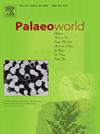Early Permian (Asselian) flora from the Talchir Formation, Son Basin, India: Biostratigraphical and palaeoenvironmental implications
IF 1.7
3区 地球科学
Q2 PALEONTOLOGY
引用次数: 0
Abstract
The Talchir Formation (Asselian–Sakmarian), the lowermost non-coaliferous sedimentary sequence of the Lower Gondwana Group is of utmost significance to understand evolution and proliferation of the Glossopteris Flora in the Gondwanan continents. After the Carboniferous deglaciation, a distinct new flora, i.e., the Glossopteris Flora appeared in the southern high palaeolatitudes during the onset of the Permian. This flora is widely distributed in the Permian successions of Peninsular India and sporadically distributed in extra Peninsular, i.e., Himalayan regions of India. Therefore, floral records obtained from the Talchir Formation are pertinent to understanding the evolution and radiation of the Glossopteris Flora. The present study assesses the early Permian floral diversity, palaeoenvironment, and palaeoclimate inferred from Talchir deposits of Chirmiri area, Son Basin, Chhattisgarh, India. This study considerably adds to our current understanding of the radiation of the early Glossopteris Flora in India immediately after the Permian–Carboniferous deglaciation. A rich macroflora has been recovered from reddish siltstone and grey shale units of two sections of the Talchir Formation and is the largest floral composite recovered so far, from this formation. The floral assemblage reveals dominance of Cordaitales (Noeggerathiopsis and Euryphyllum), Equisetales (Paracalamites) followed by Glossopteridales (Gangamopteris, Glossopteris, scale leaf and seed). The prolific occurrence of Cordaitales implies that this plant group was also flourishing on the raised grounds along with glossopterids during the early Permian. Typical Euryphyllum-Noeggerathiopsis-Gangamopteris assemblage suggests that studied strata is of ‘Upper Floristic zone’ of the Talchir equivalent to ‘Rikba beds’ and is Asselian in age. Furthermore, the occurrence of thick reddish colour siltstone units indicates localized ‘Red beds’ and shift in climate from cool humid to arid. The floral composite is corroborated with coeval flora of India and other Gondwana continents to understand palaeogeographical distribution of these plant groups. The floral composition suggests the existence of terrestrial marshy ecosystem with cooler climatic conditions.
印度Son盆地Talchir组早二叠世(Asselian)植物群:生物地层和古环境意义
Talchir组(Asselian-Sakmarian)是下冈瓦纳群(Lower Gondwana Group)最下层的非煤系沉积层序,对了解冈瓦纳大陆的gloopteris植物群的演化和繁殖具有重要意义。石炭世脱冰后,在二叠纪开始时,在南方高纬度地区出现了一种独特的新植物群,即舌蕨植物群。该植物群广泛分布于印度半岛的二叠系,零星分布于印度半岛外的喜马拉雅地区。因此,从Talchir组获得的植物记录有助于了解舌蕨植物区系的演化和辐射。本文对印度恰蒂斯加尔邦Son盆地Chirmiri地区Talchir沉积物的早二叠世植物多样性、古环境和古气候进行了研究。这项研究极大地增加了我们目前对二叠纪-石炭纪冰川消退后印度早期舌苔植物群辐射的理解。从塔尔奇尔组的两个剖面的红色粉砂岩和灰色页岩单元中发现了丰富的大型植物群,是迄今为止从该组中发现的最大的植物群。花类组合以Cordaitales (Noeggerathiopsis和Euryphyllum)、Equisetales (Paracalamites)为主,其次是舌蕨科(Gangamopteris、舌蕨、鳞叶和种子)。Cordaitales的大量出现表明,在二叠纪早期,这种植物群也与舌蕨一起在凸起的地面上繁盛。典型的euryphylum - noeggerathiopsis - gangamopteris组合表明所研究的地层属于Talchir的“上植物区”,相当于“Rikba层”,年龄为亚塞利亚。此外,厚红色粉砂岩单元的出现表明了局部的“红层”和气候从凉爽潮湿向干旱的转变。通过与印度和其他冈瓦纳大陆的同时期植物区系的对比,了解了这些植物群的古地理分布。植物组成表明存在气候条件较冷的陆生沼泽生态系统。
本文章由计算机程序翻译,如有差异,请以英文原文为准。
求助全文
约1分钟内获得全文
求助全文
来源期刊

Palaeoworld
PALEONTOLOGY-
CiteScore
4.00
自引率
5.90%
发文量
95
期刊介绍:
Palaeoworld is a peer-reviewed quarterly journal dedicated to the study of past life and its environment. We encourage submission of original manuscripts on all aspects of palaeontology and stratigraphy, comparisons of regional and global data in time and space, and results generated by interdisciplinary investigations in related fields. Some issues will be devoted entirely to a special theme whereas others will be composed of contributed articles. Palaeoworld is dedicated to serving a broad spectrum of geoscientists and palaeobiologists as well as serving as a resource for students in fields as diverse as palaeobiology, evolutionary biology, taxonomy and phylogeny, geobiology, historical geology, and palaeoenvironment.
Palaeoworld publishes original articles in the following areas:
•Phylogeny and taxonomic studies of all fossil groups
•Biostratigraphy, chemostratigraphy, chronostratigraphy
•Palaeoecology, palaeoenvironment and global changes throughout Earth history
•Tempo and mode of biological evolution
•Biological events in Earth history (e.g., extinctions, radiations)
•Ecosystem evolution
•Geobiology and molecular palaeobiology
•Palaeontological and stratigraphic methods
•Interdisciplinary studies focusing on fossils and strata
 求助内容:
求助内容: 应助结果提醒方式:
应助结果提醒方式:


